If you have a listen, this should prove to be a really good, informative chat about cannabis landraces with the Aussie Gunja Project….
Yet again, though, I’ve recorded a podcast after a night of next to no sleep and way too much coffee….
But the questions were excellent and I reckon they really opened up the topic for people wanting to go deeper into the history, botany, and culture of old-school cannabis….
***
The top photo shows a maintenance grow of a feral population from Humla by @biointensive_cannabis
Humla is a remote mountain district of Far West Nepal bordering Tibet.
In terms of the mythology or sacred geography of Cannabis, the significance of Humla is that it’s an old route to Mount Kailash, which is the mountain abode of Shiva and Parvati.
Origin stories of Cannabis found in alchemical texts such as the Ānandakanda relate a primordial event called ‘The Churning of the Ocean’.
There are various versions of the story, but as they pertain to Cannabis and other ‘drugs’ such as opium, tobacco, and datura, all of them encode the essential ambivalence of intoxicating substances as part ambrosia, part poison.
The story goes that while in search of amrita or ambrosia, the elixir of immortality, the Devas and Asuras agree to cooperate together in the churning of the primordial Ocean of Milk.
To do so, they overturn Mount Meru, the world axis, wrapping the great Naga serpent Vasuki around the mountain and using him as a churning rope.
Various wonders emerge from the ocean depths, but before the manifestation of the amrita, there appears a terrible poison called hālāhala.
Hālāhala is so virulently toxic that it threatens to destroy all of creation – until Shiva comes to the rescue, carrying it away in his drinking bowl to his cave on Mount Kailash.
Drinking down the deadly draught, which turns his throat blue before even he – the Lord of Yogis – can apply his power, Shiva transforms the poison into amrita.
Satisfied, Shiva overturns his emptied cup, but a few last drops of the hālāhala drain out down the valleys of the Himalaya and from these there originate the first Cannabis plants.
***
This accession was collected along the Karnali River on one of the main routes up to Kailash.
Broad leaflets – i.e., high W / L ratios – in early vegetative stage are common in Himalayan populations and may perhaps indicate they have an origin further north in Central Asia – i.e., Tibet.






